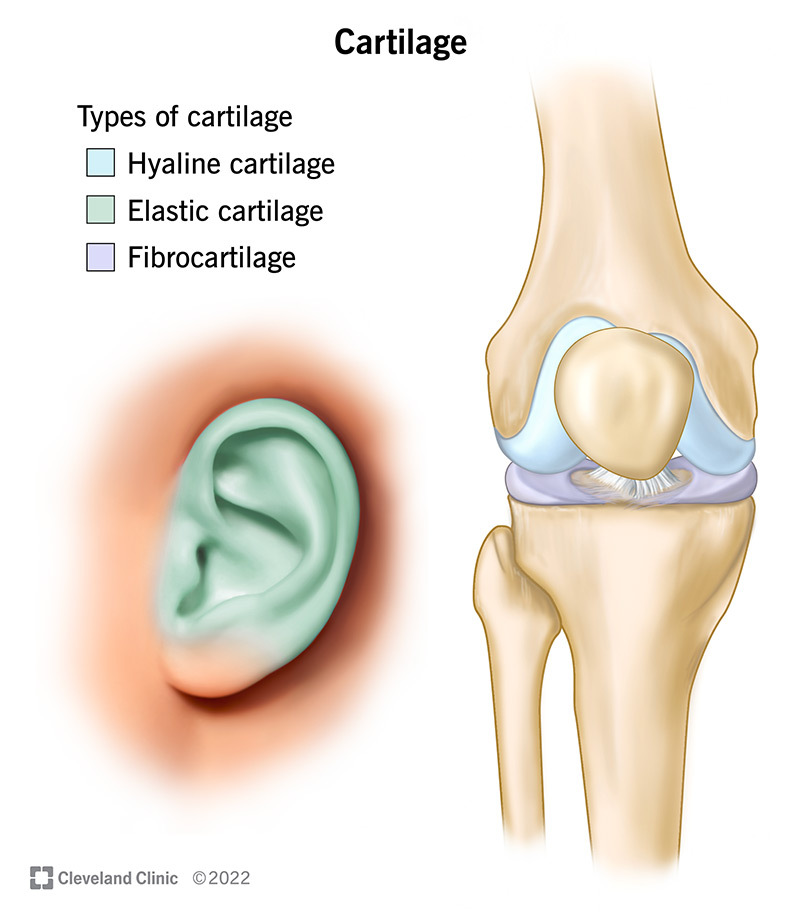There are three types of cartilage in your body. Cartilage does everything from helping your joints move smoothly to absorbing impacts. Your nose and ears are made of cartilage. Cartilage damage is one of the most common results of sports injuries and other traumas. How long it takes to recover depends on where the injury is and how severely your cartilage is torn.
Advertisement
Cleveland Clinic is a non-profit academic medical center. Advertising on our site helps support our mission. We do not endorse non-Cleveland Clinic products or services. Policy

Cartilage is a strong, flexible connective tissue that protects your joints and bones. It acts as a shock absorber throughout your body.
Advertisement
Cleveland Clinic is a non-profit academic medical center. Advertising on our site helps support our mission. We do not endorse non-Cleveland Clinic products or services. Policy
Cartilage at the end of your bones reduces friction and prevents them from rubbing together when you use your joints. It’s also the main tissue in some parts of your body and gives them their structure and shape.
Damage to your cartilage can happen suddenly — like a sports injury or other trauma — but it can also build up over the course of your life and lead to osteoarthritis.
Anything that injures or damages your cartilage can make it hard or impossible to use your joints the way you’re used to.
Cartilage protects your bones and joints. It surrounds the ends of your bones and cushions the spaces in your joints where bones meet. Cartilage has three jobs:
Advertisement
Cartilage is also the main tissue in some parts of your body including your:
Almost any place where two bones meet in your body is cushioned by cartilage. It’s also at the ends of all your bones that form joints.
There are three types of cartilage in your body:
Hyaline cartilage is the most common type of cartilage in your body. It lines your joints and caps the ends of your bones. Hyaline cartilage at the ends of your bones is sometimes referred to as articular cartilage.
Hyaline cartilage is slippery and smooth which helps your bones move smoothly past each other in your joints. It’s flexible but strong enough to help your joints hold their shape.
Hyaline cartilage locations in your body include:
Fibrocartilage is what its name sounds like: tough cartilage made of thick fibers. It’s the strongest and least flexible of the three types. It’s tough enough to hold parts of your body in place and absorb impacts.
Fibrocartilage locations in your body include:
Elastic cartilage is your most flexible cartilage. It supports parts of your body that need to bend and move to function. Elastic cartilage can bounce back to its original shape, even after a strong force. Your ear is made of elastic cartilage. It can bend and move without hurting you before returning to its usual shape.
Elastic cartilage locations in your body include:
The most common issues that affect your cartilage include:
Advertisement
Your healthcare provider usually won’t check your cartilage on its own. Instead, they’ll perform a physical exam to feel for damage or to diagnose your symptoms, or will use imaging tests to see inside your body, including:
How your injured cartilage is treated depends on where in your body it is, and how it was damaged. Usually, if you tear or rupture cartilage, you’ll also hurt other parts near it. Your provider or surgeon will focus on treating your whole injury, which will involve the cartilage.
Some cartilage injuries heal on their own with rest and time, but others require surgery (usually an arthroscopy) to repair. Your surgeon might stitch your cartilage back together, but they also might reshape it (you might see this referred to as trimming or shaving) to restore its function. Talk to your provider or surgeon about what to expect and how long it will take to recover.
Because cartilage is avascular (a medical term meaning it doesn’t directly receive blood flow), it usually takes longer to heal than other parts of your body.
General healthy habits will help your cartilage (and the structures it supports) work like it should, including:
Advertisement
If you’re recovering from an injury, follow your provider’s or surgeon’s instructions to help your body heal. You might need to avoid using the injured part of your body for a few weeks (or longer).
Cartilage is an important part of your ability to stand, move and do anything else that uses your joints and bones. It absorbs shocks and helps your bones move smoothly.
If you injure your cartilage — especially in a joint — it might take a while to recover. But don’t rush your body’s healing process. If you resume physical activities like sports or running before your cartilage has fully healed, there’s a good chance you’ll re-injure it.
Advertisement
From sudden injuries to chronic conditions, Cleveland Clinic’s orthopaedic providers can guide you through testing, treatment and beyond.

Last reviewed on 05/24/2022.
Learn more about the Health Library and our editorial process.